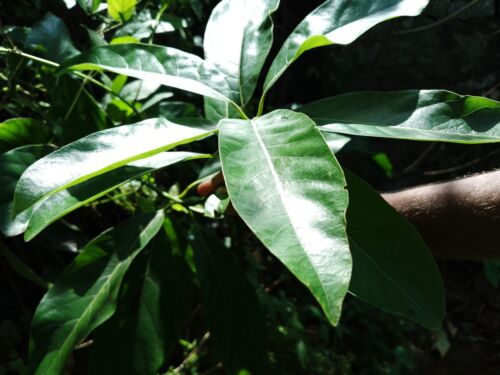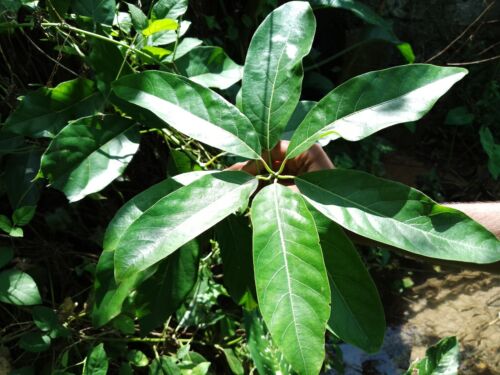Blog
The Hidden Gem: Unearthing the Traditional Healing of Acronychia Pedunculata (Claw-flowered Laurel)

Claw Flowered Laurel
In the vibrant biodiversity of our planet, there exist countless plants whose profound healing properties are yet to be fully embraced by the wider world. Today, we turn our attention to one such botanical treasure: Acronychia pedunculata. While its scientific name might sound complex, this remarkable tree holds a significant place in traditional medicine, especially in its native South and Southeast Asia.
Here in Sri Lanka, we know it affectionately as Lunuankenda (ලුණුවංකෙන්ද) or sometimes simply Ankenda (අංකෙන්ද). Its distinctive, claw-shaped flowers give it the charming English name Claw-flowered Laurel. While you might encounter it as the “White Buttonwood” in some regions, its true value lies far beyond its ornamental appeal.
For generations, the leaves, bark, and even roots of Acronychia pedunculata have been a secret ingredient in Ayurvedic and other traditional healing systems. Let’s explore the powerful health benefits this often-overlooked plant has to offer.
A Plant of Many Aliases: Uniting Traditional Wisdom
Part of the journey in understanding lesser-known herbs is recognizing them across different cultures. Here are some of the names you might encounter for Acronychia pedunculata:
- Botanical Name: Acronychia pedunculata (Your primary keyword for an international audience)
- Common English Names: Claw-flowered Laurel, White Buttonwood (secondary keywords for discoverability)
- Sinhala (Sri Lanka): Lunuankenda (ලුණුවංකෙන්ද), Ankenda (අංකෙන්ද) (crucial for local context and authenticity)
- Malayalam (India): Vidukanni
- Thai: Ka-dang-nga
This rich tapestry of names underscores its widespread traditional use and the diverse cultural appreciation for its therapeutic qualities.
The Remarkable Health Benefits of Acronychia Pedunculata (Lunuankenda)

The leaves, in particular, are considered a powerhouse, traditionally prepared as decoctions, poultices, or incorporated into herbal formulas.
1. A Natural Digestive Aid
One of the most prominent traditional uses of Acronychia pedunculata is its ability to support digestive health. The leaves are often brewed into a tea to alleviate indigestion, stomach aches, and bloating. They are believed to possess carminative properties, which help expel gas, and can also act as a mild laxative to promote healthy bowel movements. This makes Lunuankenda a valuable remedy for maintaining gastrointestinal comfort.
2. Potent Anti-inflammatory and Pain-Relieving Properties
The plant is rich in bioactive compounds that exhibit significant anti-inflammatory and analgesic (pain-relieving) effects. Traditionally, a paste made from the leaves or bark is applied externally to swollen joints, sprains, and areas of muscular pain. Internally, decoctions are consumed to help reduce systemic inflammation and discomfort, making it a natural ally against various inflammatory conditions.
3. Supports Skin Health and Wound Healing
With its antiseptic and astringent qualities, Lunuankenda leaves have been historically used for topical applications to promote skin health. A poultice applied to minor cuts, wounds, and skin irritations can help prevent infection, reduce inflammation, and accelerate the healing process. It’s a testament to nature’s own first-aid kit.
4. Fever Reduction and Immune Support
In traditional medicine, decoctions of Acronychia pedunculata have been administered to help reduce fevers. Its purported ability to support the body’s natural response to illness, combined with its anti-inflammatory properties, makes it a valuable herb during times of seasonal discomfort and for overall immune system support.
5. Antioxidant Powerhouse
Preliminary scientific studies are beginning to confirm what traditional healers have long known: Acronychia pedunculata is rich in antioxidants. These compounds help combat oxidative stress caused by free radicals in the body, which can contribute to various chronic diseases. By neutralizing these harmful elements, the plant helps protect cells and promotes overall cellular health and vitality.
Integrating Lunuankenda into Modern Wellness

While the traditional uses of Acronychia pedunculata are profound, it’s vital to approach any herbal remedy with an informed perspective. As research continues to unfold, this remarkable plant holds immense promise.
If you are considering incorporating Lunuankenda (Claw-flowered Laurel) into your health regimen, especially in powdered or extract form, we always recommend consulting with a qualified healthcare professional or an experienced Ayurvedic practitioner. They can offer personalized advice on its appropriate use, dosage, and potential interactions with any existing health conditions or medications.
From the lush landscapes of Sri Lanka to the global stage of natural wellness, Acronychia pedunculata stands as a vibrant symbol of nature’s enduring power to heal and nourish.
Disclaimer: This article is for informational and educational purposes only and does not constitute medical advice. The information provided is based on traditional uses and available scientific literature but is not a substitute for professional medical consultation, diagnosis, or treatment. Please consult with a qualified healthcare provider before using any herbal product, especially if you have a pre-existing medical condition, are pregnant or nursing, or are taking medication.
Claw Flowered Laurel seeds
Claw Flowered Laurel leaf
Claw Flowered Laurel tree
Claw Flowered Laurel benefits
Claw Flowered Laurel uses
Claw Flowered Laurel stone breaker
Claw Flowered Laurel capsules

Discover more from Nath Mart
Subscribe to get the latest posts sent to your email.
